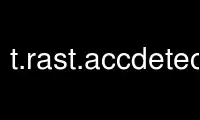
This is the command t.rast.accdetectgrass that can be run in the OnWorks free hosting provider using one of our multiple free online workstations such as Ubuntu Online, Fedora Online, Windows online emulator or MAC OS online emulator
PROGRAM:
NAME
t.rast.accdetect - Detects accumulation patterns in temporally accumulated space time
raster datasets created by t.rast.accumulate.
KEYWORDS
temporal, accumulation, raster, time
SYNOPSIS
t.rast.accdetect
t.rast.accdetect --help
t.rast.accdetect [-nr] input=name [minimum=name] [maximum=name] occurrence=name
[indicator=name] start=string [stop=string] cycle=string [offset=string]
basename=string [range=min,max] [staend=start,intermediate,end] [--overwrite]
[--help] [--verbose] [--quiet] [--ui]
Flags:
-n
Register empty maps in the output space time raster dataset, otherwise they will be
deleted
-r
Reverse time direction in cyclic accumulation
--overwrite
Allow output files to overwrite existing files
--help
Print usage summary
--verbose
Verbose module output
--quiet
Quiet module output
--ui
Force launching GUI dialog
Parameters:
input=name [required]
Name of the input space time raster dataset
minimum=name
Input space time raster dataset that specifies the minimum values to detect the
accumulation pattern
maximum=name
Input space time raster dataset that specifies the maximum values to detect the
accumulation pattern
occurrence=name [required]
The output space time raster dataset that stores the occurrence of the the
accumulation pattern using the provided data range
indicator=name
The output space time raster dataset that stores the indication of the start,
intermediate and end of the specified data range
start=string [required]
The temporal starting point to begin the accumulation, eg ’2001-01-01’
stop=string
The temporal date to stop the accumulation, eg ’2009-01-01’
cycle=string [required]
The temporal cycle to restart the accumulation, eg ’12 months’
offset=string
The temporal offset to the begin of the next cycle, eg ’6 months’
basename=string [required]
Basename of the new generated output maps
A numerical suffix separated by an underscore will be attached to create a unique
identifier
range=min,max
The minimum and maximum value of the occurrence of accumulated values, these values
will be used if the min/max space time raster datasets are not specified
staend=start,intermediate,end
The user defined values that indicate start, intermediate and end status in the
indicator output space time raster dataset
Default: 1,2,3
DESCRIPTION
t.rast.accdetect is designed to detect accumulation pattern in temporally accumulated
space time raster datasets created by t.rast.accumulate. This module expects a space time
raster dataset as input that is the result of a t.rast.accumulate run.
The start time and the end time of the pattern detection process must be set, eg.
start="2000-03-01" end="2011-01-01". The start and end time do not need to be the same as
for the accumulation run that produced the input space time raster dataset. In addition a
cycle, eg. "8 months", can be specified, that defines after which time interval the
accumulation pattern detection process restarts. The offset option specifies the time
between two cycles that should be skipped, eg. "4 months". Please make sure that the cycle
and offset options are same as in the accumulation process that produces the input space
time raster dataset, otherwise the accumulation pattern detection will produce wrong
results.
The minimum and maximum values of the pattern detection process can be set, either by
using space time raster datasets or by using fixed values for all raster cells and time
steps.
Using space time raster datasets allow specifying minimum and maximum values for each
raster cell and each time step. For example, we want to detect the germination (minimum
value) and harvesting (maximum value) dates for different crops in Germany using the
growing-degree-day (GDD) method for several years. Different crops may grow in different
raster cells and change with time because of crop rotation. Hence we need to specify
different GDD germination/harvesting (minimum/maximum) values for different raster cells
and different years.
The raster maps that specifies the minimum and maximum values of the actual granule will
be detected using the following temporal relations: equals, during, overlaps, overlapped
and contains. First all maps with equal time stamps to the current granule of the input
STRDS will be detected, the first minimum map and the first maximum map that were found
are used as range definitions. If no equal maps are found then maps with a temporal during
relation are detected, then maps that temporally overlap the actual granules, until maps
are detected that have a temporal contain relation. If no maps are found or
minimum/maximum STRDS are not set, then the range option is used, eg. range=480,730.
The base name of of the generated maps must always be set.
This module produces two output space time raster datasets. The occurrence output STRDS
stores the time in days from the begin of a cycle for each raster cell and time step that
has a value within the minimum and maximum definition. These values can be used to compute
the duration of the recognized accumulation pattern. The indicator output STRDS uses three
values, that can be set using the staend option, to mark raster cells with integer values
that indicate the start, the intermediate state and the end of a accumulation pattern. As
default specifies the value 1 the start, the value 2 the intermediate state and the value
3 the end of the accumulation pattern in a cycle.
EXAMPLE
Please have a look at the t.rast.accumulate example.
Use t.rast.accdetectgrass online using onworks.net services
